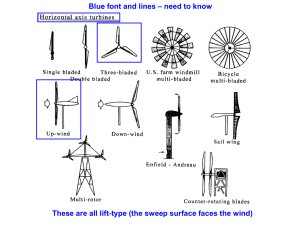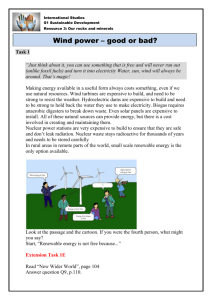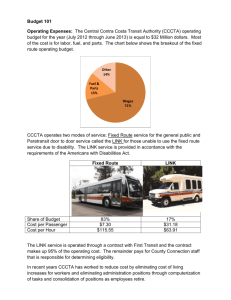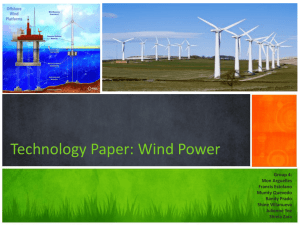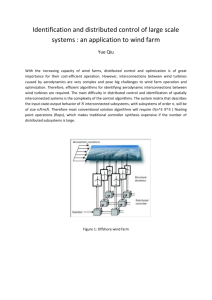Construction Phase - Horizons Regional Council
advertisement
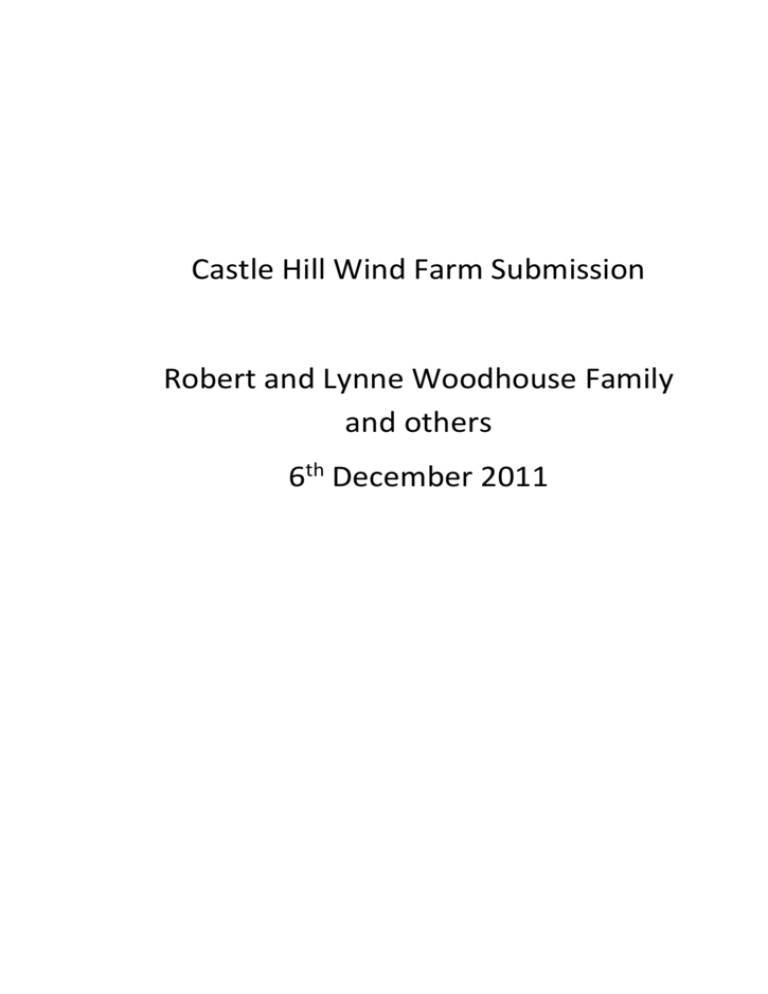
Castle Hill Wind Farm Submission Robert and Lynne Woodhouse Family and others 6th December 2011 1. My name is Robert John Woodhouse and I in partnership with my wife Lynne Margaret Woodhouse farm Rakaunui. Rakaunui comprises of some 980 ha including the site of Rakaunui Township extending both sides of Route 52, Huia Road and East to Waihoki Road. We run almost exclusively sheep for meat and wool numbering some 15,500 head. Rakaunui has been farmed exclusively by the Woodhouse family since Jack and Emily Woodhouse settled in 1895. We live at 11853 Route 52 in the house built by my Great Grandfather Jack Woodhouse. Land farmed by his Mother in law Barbara Roberts (my Great Great Grandmother) has long been included. This makes our children the 6th generation on the farm and the 5th generation to live in the same house. Photo taken 1963 Alfred Woodhouse, John Woodhouse, Emily Woodhouse and Robert Woodhouse. Four generations, I still live in this house. 1. I was born in Pahiatua Hospital in 1958 and apart from spending 4 years boarding at Wairarapa College 1971 – 74, I have lived exclusively on Rakaunui. Along with farming Rakaunui for 37 years, I am currently Licensee for Pongaroa Early Years Pre-School and Treasurer for Pongaroa Community Buses. I served on Pongaroa School BOT for 10 years including 2 terms as Chairman. 2. Lynne married me in 1987 and has lived on Rakaunui ever since. Along with actively farming Rakaunui she is a relief driver for Pongaroa Community Buses, competes with the Wairarapa Endurance/CTR Horse Club and is involved with Wairarapa Riding for the Disabled Association. 3. We have 3 children Samantha, Kathryn and Olivia who have educational, sporting and social contacts in Masterton and Palmerston North. 4. My mother Nancy Woodhouse lives in Masterton and keeps a house on Rakaunui travelling Route 52 between the two. 5. Martin Hull farms on Coast Road Pongaroa within view of CHWF turbines and has family and business contacts in Masterton including a child boarding at Wairarapa College. 6. Dinah Bowie farms on Manuhara Road Pongaroa within view of CHWF turbines and has family and business contacts in Masterton including a child boarding at St Mathews College. 7. Lynne and I are both members of Castle Hill Wind farm Community Action Group (CHWCAG) And we both fully endorse their submission. 8. We respectfully ask you as Commissioners not to grant consent for building Castle Hill Wind Farm because many adverse effects cannot be mitigated. If you feel unable to deny consent we ask you to consider the mitigation suggested to make life tolerable. We have examined the different effects in both the Construction Phase and the Production Phase. Construction Phase Road Design Route 52 (Tiraumea to Rakaunui at Rimu Rd intersection) 9. This section of road some 11km in length is single lane, narrow and winding, with a series of short 2 lane sections comprising of about 1km in total. Rakaunui has a Route 52 road boundary of about 5km, with half of that being both sides of the road. This road is proposed as the access to Turbine cluster “A” at both Rakaunui Road and Rimu Roads. As identified by Genesis this road doesn’t even meet the minimum recommended standards for the traffic volumes already using the road. Suggested volume increases during construction of CHWF will render the road completely inadequate and totally unsafe. 10. There are places a car and heavy vehicle cannot safely pass (4.2 metre width, Genesis) and I personally have experienced many near misses. This section doesn’t figure in the injury accident report however non-injury accidents are common and are not usually reported. Low vehicle speeds and volumes contribute to non-injury outcomes. 11. Route 52 was State Highway 52 and was sadly neglected. In the 1980s this road was identified as one of only 2 highways in NZ that was still unsealed and unimproved. I was involved in a community group that lobbied Government to improve the road. Government of the day responded by revoking the highway status. However Tararua District Council negotiated that the road be sealed to reduce costs to ratepayers before they agreed to take over funding of the road. Traffic volumes were light on this section so only a single lane 5 metre carriageway was built on minimal foundation. Residents were promised that the road would be widened to 2 lanes during repairs after flood damage events (a regular occurrence due to the very unstable nature of the mudstone country) 12. Upgrading Route 52 to meet specification will be a major undertaking. This area is crisscrossed with earthquake faultlines, deep seated earth slides, greasy back slips and bentonite. These features make road building in this area an increased engineering challenge. Bob Smith, the only engineer with long term particular experience in this area has passed away and it may be difficult to find engineers with practical experience in these problems. Local knowledge will be essential and we wish to be consulted on upgrade design within Rakaunui road frontage. Stock Movement 13. Traditionally roads have been used as stock access on farms and this was this case at Rakaunui when stock was regularly driven along the 5km Route 52 road frontage. Over the last 10 years and as the road has been sealed we have built stock lanes and now constrict stock movement to 2 crossing points and less than 1km of droving from the woolshed. 14. To move sheep around Rakaunui Farm is essential for management, health and safety and animal welfare. Mobs of sheep often exceed 2500 head and it takes 15 minutes to cross the road and up to 30 minutes to drive a mob of this size 1km. Likely monthly total crossings November Main Shear 10,000 head 20 crossings December Weaning/Lamb shear 10,000 head 20 crossings Drenching 5000 head 6 crossings Drenching 8000 head 8 crossings Dipping 15000 head 30 crossing January February Drenching 7000 head 8 crossings Shearing 2000 head 4 crossings Drenching 6000 head 6 crossings Crutching 6000 head 12 crossings April Drenching 5000 head 6 crossings May Drenching 4000 head 6 crossings Shearing 1500 head 4 crossings June Drenching 4000 head 6 crossings July Drenching 3500 head 6 crossings Crutching 5500 head 10 crossings Drenching 3000 head 6 crossings Shearing 2000 head 4 crossings September Drenching 2500 head 4 crossings October Drenching 2000 head 4 crossings March August 15. Sheep movement is highest November to April. Given Genesis proposed traffic volumes during construction conflict between heavy trucks and mobs of our sheep will be regular. Traffic will experience delays and people, dogs and sheep will at increased risk of injury and the farm will be very difficult to run. Farm Machinery Movement 16. Rakaunui has a programme of fertilizer application, cultivation, silage making and roading and water supply maintenance. We run a fleet of 5 wheel tractors, 3 heavy trucks, 2 bulldozers, an excavator and a wheeled loader. Our Case MX210 wheeltractor weighs 11t, 210hp and measures 3.4 metres in width and is fully road legal. Rakaunui has access points on Rimu road, Route 52, Huia road and Waihoki road and we will be traversing these roads especially during summer months. At current traffic volumes we experience few problems however given Genesis proposed volumes conflicts will occur. A 2.5 metre Genesis truck and our 3.4 metre wheeltractor cannot pass on a 5 metre road. We may well be towing 2 or more trailed implements and it will be almost impossible for us to backup so the time taken to disconnect our gear and clear the road will lead to considerable delays. Travel to town 17. We need to travel Route 52 to Masterton. The simple fact is, this end of Route 52 was never designed for more than light traffic volumes. The delays and frustrations from overloading this road is a more than a minor effect. I drive heavy vehicles and I know that there are very few places to safely pull off the road to let following traffic past. High opposing traffic volumes will hinder safe passing of heavy or slow vehicles. Traffic Noise/times 18. Our house is situated 30 metres from the road boundary and my bedroom is situated on the front roadside corner. Currently I sleep well but like most rural people I am very security conscious so I observe most traffic going past at night. I don’t sleep well in high traffic areas in town. Heavy trucks make much more noise/vibrations than cars. High night time traffic volumes may well have serious implications on me and my family’s health due to sleep disruption. Safety/school buses 19. Pongaroa Community Buses runs 5 Ford Transit buses delivering children to Pongaroa School and Pongaroa Early Years Preschool. Being community owned these buses are available to pick up any children within the Pongaroa School catchment zone with extensions possible for pre-schoolers. The halfway point between Pongaroa and Alfredton schools falls just south of Tiraumea. Currently Pongaroa Community Buses operates one bus in the proposed Genesis construction zone, travelling Route 52 and Waihoki road to pick up children. There is the potential to pick up pre-schoolers on Haunui road and Route 52 south of Tiraumea and future extensions to Huia and Rimu roads. 20. Pongaroa Community Buses is experienced at providing a service on narrow dangerous rural roads with low traffic volumes. Safety will never be compromised. Buses are replaced after 3 years so the latest safety technology is used and all passengers have a full 3 point sash safety belt. The drivers are all local, very experienced and highly trained. The residents are very aware of school bus times and warn bus drivers and other traffic of conflicts. 21. There has been one injury accident in the last ten years on the Range road when a 4wd ute was unable to stop on the gravel surface and slid into the stopped bus. Even at low total speeds the impact was enormous with the Ford Courier ute behind a steel bullbar being destroyed and the near new Ford Transit Bus needing $29,000 worth of repairs. Luckily no children were on the bus and the bus driver was unhurt. I was the first of Pongaroa Community Buses Management Committee on the scene and I do not wish to ever attend another school bus accident. 22. With the high traffic volumes and very high percentage of heavy trucks on Route 52 and Waihoki roads during the construction phase I believe that the school bus service will have to be withdrawn for safety reasons. Radios and other warning devices will be totally inadequate mitigation. The only solution would be to upgrade the roads (Route 52 Rimu road intersection to Tiraumea and Waihoki road to the end of the construction zone) to a 2 lane sealed carriageway or to ban all construction traffic during school bus hours (8.00 to 9.00 am and 3.00 to 4.00pm) Production Phase Disruption to enjoyment of amenities/business/health and safety 23. Once built the CHWF will have a profound detrimental effect on the running of Rakaunui, the ability to do our day to day business and our enjoyment of our property Visual 24. Rakaunui is surrounded by CHWF windmills. Cluster “A” to the North and West has turbines 2.5km from our house and hard on our farm boundary with Te Rimu Station. Cluster “B” to the south 3.4km will be visible to the other 2 residences on the farm and from our garden. Boffa claims that visual effect will be nil due to screening planting. The fact is the screening trees are a mixture of oaks, elms, chestnuts and other deciduous trees and will be bare for 7 months of the year. Cluster “A” turbines will be visible from all the front rooms of the house including the kitchen table. Boffa also completely fails to take into account that our working hours are spent on the farm often on ridge lines where at least Clusters “A, B, C and D” and perhaps “E, F and G” will be visible. We can see Mount Holdsworth, Rangitumau, Waitawhiti and Castlehill high country from vantage points on the property. 25. We don’t like looking at windmills. 26. 150 metre tip height turbines viewed from less than 3km are intimidating unnatural constructions that draw your eye to movement. Some Cluster “A” turbines are that close to our house and most of “A” and some of “B” are within that distance of Rakaunui boundaries. 27. Worse than that, in Cluster “A” one 110m Rotor Turbine Corridor circle touches our property and another circle is bisected by our boundary (Castle Hill Wind Farm Woodhouse General Information May 2011) using the scale on that drawing (35mm/1km) and assuming the centre of the circle is the preferred site for the turbine, that places a 110m rotor turbine within 50m and a corridor of 0m to 210m from our property and another at 210m and a corridor of 0m to 420m. A fill area and an underground cable touch our property. This hill top is a sacred family site and is therefore also a serious cultural issue. It is unreasonable to expect us to be disrupted by turbines that close. 28. The specifications of the amount and height of fill to be placed against our property has not been revealed. 29. More than half the total CHWF windmill sites are likely to be visible from our property. Depending on how many mills are actually built, this could total more than 100. Most of the Mighty River Project on the Puketoi Range as proposed will be visible and probably some of the Waitahora Turbines. Negativity generated by the cumulative effects of these projects will be reinforced every time a windmill is sighted. 30. When we travel on the road it will be worse. The iconic view from the Pongaroa/Pahiatua road at the Puketoi Saddle looking South (Alfredton Action Group submission) will be badly polluted. Travelling South to Masterton down Route 52 through Alfredton and the Whangaho valley will expose most of the CHWF Turbine sites. Noise 35. CHWF turbines will be close enough for us to hear. We endorse the CHWCAG submission on noise. Genesis (Marshall Day Acoustics, Residence Information Pack May 2011) estimates that noise will approximate 34 dB at our residence. We are not aware of any background noise studies being done at our residence and it is likely that noise effects will vary due to many factors unique to each site. 36. We assume that noise will be audible and will be at least at nuisance levels. This opens the possibility of health effects due to sleep disturbance. 37. Also to consider is the fact that some proposed turbine are very close to our property/workplace and noise in these areas will exceed 40dB. Radio/cell phone/broadband 35. Telephone landline. Our telephone is connected by underground cable to an exchange sited approx. 11810 Route 52 and from there via a radio link through Cluster “A” to Mount Butters. This link doesn’t appear to have been assessed. We need assurance that any unforeseen effect compromising our Telephone will be mitigated. 36. Cell phone/Mobile Broadband We connect to the cell phone network at Mount Butters. The radio signal passes through Cluster “A”. Cell phones/Mobile Broadband are vital for communication on Rakaunui. This is important for health and safety and efficient running of our business. The signal is good to marginal to no signal at different sites. Any degradation of the signal will reduce the effectiveness of this vital link. We need assurance that any unforeseen effect compromising our Cell phone/Mobile Broadband will be mitigated. Flicker effect 37. Shadow flicker is the moving shadow thrown by sunlight passing though rotating turbine blades (CHWF telecommunication, aviation and shadow flicker information 04/11) considered significant within 10 times the rotor diameter or 1.1km from a turbine. A moving shadow passing under a horse especially a horse unfamiliar with the effect is a significant safety hazard for the rider (Wind Farm Threat in Wales, Horse and Hound 12/7/04) 38. Horses are essential for safe transportation around steeper ground and during wet seasons on Rakaunui. 39. The hill country conditioning of long distance endurance horses is an essential component of the training required for the enjoyment of competing at NZ Equestrian Endurance Horse events for Lynne, Kathryn and Olivia Woodhouse and their friends. 40. Lynne, Samantha, Kathryn and Olivia Woodhouse and their friends ride for pleasure around the hills of Rakaunui. Horses belonging to Wairarapa Riding for the Disabled spend the school holidays at Rakaunui and are conditioned through hill country work. 41. A significant area of Rakaunui including some of the best riding trails will become unsafe for horse riding. Aircraft obstruction 42. Light aircraft operation is essential for health and safety and efficient running of Rakaunui. 43. The safest and only practical method of applying fertilizer to steep hill country is by aircraft. The placement of turbines very close to Rakaunui will create areas that cannot be top-dressed and will increase costs by increasing flight times to negotiate turbine towers. 44. The saddle in the Puketoi Ranges North of Mount Butters directly over the Pongaroa/Pahiatua road is very important for light aircraft flying under visual rules. Low cloud and fog can completely isolate the area East of Puketoi Ranges except for the small open area through the gap in the Puketoi Range (referred as “shooting the gap” by many of the old fert plane pilots). Light planes need to operate in light air often only found early in the morning. Flying directly through the gap and not waiting for the fog to lift adds many possible flying hours. 45. The gap is often used by the Rescue Helicopter and while they can usually fly around the Puketoi Range the extra 15 minutes may prove to be fatal in a life and death situation. Cluster “A” is situated directly in line with the gap and the extra height required to fly over the turbines may force light aircraft into the clouds effectively “closing the gap”. Lapse period 46. We endorse the CHWCAG submission on the lapse period and construction times of 5 years lapse and 7 years construction. We feel that CHWF is very unlikely to be built and that it would be very unfair and unsettling for residents to have an unfulfilled consent affecting their planning for years to come. If CHWF is to be build that seems a more than adequate time. Transmission lines 47. CHWF application includes no provision for external transmission lines. These lines would be 220kva lines on at least 60m towers and require consent under the Tararua District Plan. CHWF cannot be built without a connection to the National Grid. Mighty River is seeking consent for a line to their proposed Puketoi Wind farm. A line directly between the CHWF Waihoki substation and the Puketoi substation may pass over or very close to Rakaunui Farm. This would open a new set of detrimental effects to be planned for including construction including an increased cumulative effect. Tower removal 48. Derelict infrastructure including obsolete turbines remaining at the end of the project would be an environmental blight. NZ Government has signalled that Genesis Energy will be at least partially privatised. There seems no mention that the company will be Government guaranteed. Advancements in energy generation technology over the next 50 years may render energy generating companies relying on older technology financially at risk. There must be a mechanism in place to ensure that bankruptcy does not hinder end of project rehabilitation. Mitigation 49. Stock movement Legislating Rakaunui livestock off the road would cause unreasonable hardship and lights and warning signs would make the exercise safer but would not address the disruption to both the traffic or farm. Two possible solutions. Duplicate facilities so road crossing is unnecessary. Woolshed, yards and loading race required. Build an underpass link under Route 52 50. Farm Machinery Movement Build 4 metre wide internal farm roads so use of external roads is unnecessary. 51. Travel to Town Build slow traffic passing bays along Route 52 inside the construction zone. 52. Traffic Noise/Times Restrict construction traffic to day light hours 53. Safety/School buses Upgrade Pongaroa school bus routes (Route 52 and Waihoki Road) to 2 lane sealed roads Or Restrict construction traffic to outside school bus travel times. (8.00 to 9.00 am and 3.00 to 4.00 pm) 54. Visual Cannot be mitigated. Offset required Delete closest most prominent Turbines (2) 55. Noise House and workplace. Cannot be mitigated. Offset required 56. Radio/cell phone/mobile broadband Monitor for unforeseen effects then build alternative infrastructure if required. 57. Flicker Effect/Shadow Delete any turbine within 1km to the East or West and 0.5km to the North of the boundary of any property with horses. 58. Aircraft Obstruction Further study Delete Cluster ”A” 59. Transmission Lines Demand transmission lines be included in application. No mitigation possible , offset required.

